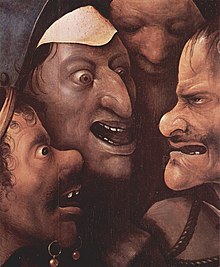
Hieronymus Bosch was a Dutch painter from Brabant. He is one of the most notable representatives of the Early Netherlandish painting school. His work, generally oil on oak wood, mainly contains fantastic illustrations of religious concepts and narratives. Within his lifetime his work was collected in the Netherlands, Austria, and Spain, and widely copied, especially his macabre and nightmarish depictions of hell.

The Garden of Earthly Delights is the modern title given to a triptych oil painting on oak panel painted by the Early Netherlandish master Hieronymus Bosch, between 1490 and 1510, when Bosch was between 40 and 60 years old. It has been housed in the Museo del Prado in Madrid, Spain since 1939.

The Haywain Triptych is a panel painting by Hieronymus Bosch, now in the Museo del Prado, Madrid, Spain. A date of around 1516 has been established by means of dendrochronological research. The central panel, signed "Jheronimus Bosch", measures 135 cm × 200 cm and the wings measure 147 cm × 66 cm. The outside shutters feature a version of Bosch's The Wayfarer.

The Seven Deadly Sins and the Four Last Things is a painting attributed to Hieronymus Bosch or to a follower of his, completed around 1500 or later. Since 1898 its authenticity has been questioned several times. In 2015 the Bosch Research Conservation Project claimed it to be by a follower, but scholars at the Prado, where the painting is on display in a sealed case, dismissed this argument. The painting is oil on wooden panels and is presented in a series of circular images.

The Conjurer is a painting by Early Netherlandish painter Hieronymus Bosch or his workshop, executed around 1502.
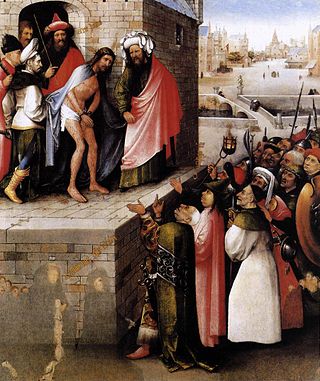
Ecce Homo is a painting of the episode in the Passion of Jesus by the Early Netherlandish painter Hieronymus Bosch, painted between 1475 and 1485. The original version, with a provenance in collections in Ghent, is in the Städel Museum in Frankfurt; a copy is held the Museum of Fine Arts in Boston. The painting takes its title from the Latin words Ecce Homo, "Behold the Man" spoken by the Roman Prefect Pontius Pilate when Jesus is paraded before a baying, angry mob in Jerusalem before he is sentenced to be crucified.
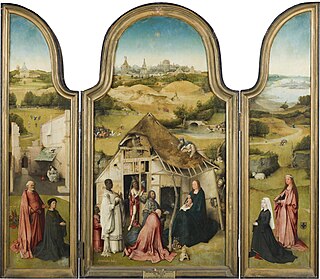
The Adoration of the Magi or The Epiphany is a triptych oil painting on wood panel by the Netherlandish artist Hieronymus Bosch, executed around 1485–1500. It is now in the Museo del Prado in Madrid, Spain.

St. Jerome at Prayer is a painting of St. Jerome by Hieronymus Bosch, thought to have been completed c. 1482. Today it is housed at the Museum of Fine Arts in Ghent.

Christ Crowned with Thorns, sometimes known as Christ Mocked, is an oil on panel painting by Hieronymus Bosch. It is held in the National Gallery in London, which dates it to around 1510, though some art historians prefer earlier dates.

Christ Crowned with Thorns is an oil on panel painting made in the 1530s by a follower of Hieronymus Bosch. It is now in the Monasterio de San Lorenzo at El Escorial, near Madrid, in Spain.

The Crucifixion of Saint Wilgefortis is a c. 1497 triptych by the Early Netherlandish painter Hieronymus Bosch. The subject of the painting has been uncertain, and it has also been known as the Triptych of the Crucified Martyr, or The Crucifixion of Saint Julia, but is now believed to depict Saint Wilgefortis.
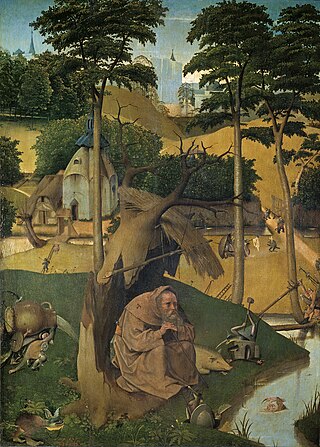
The Temptation of St. Anthony is a painting of disputed authorship, attributed to either Hieronymus Bosch or a follower. It is now in the Museo del Prado, in Madrid.

The Last Judgment is a triptych by Hieronymus Bosch, created after 1482.

Concert in the Egg is a painting formerly considered to be a copy of a lost work by Hieronymus Bosch, and which is currently considered to be based on one of his drawings. Max Jakob Friedländer called it 'an old copy', without specifying another work it was copied from.

The Triptych of Temptation of St. Anthony is an oil painting on wood panels by the Early Netherlandish painter Hieronymus Bosch, dating from around 1501. The work portrays the mental and spiritual torments endured by Saint Anthony the Great, one of the most prominent of the Desert Fathers of Egypt in the late 3rd and early 4th centuries. The Temptation of St. Anthony was a popular subject in Medieval and Renaissance art. In common with many of Bosch's works, the triptych contains much fantastic imagery. The painting hangs in the Museu Nacional de Arte Antiga in Lisbon.

The Last Judgment is a triptych of disputed authorship, either by Hieronymus Bosch, his workshop, or a collaboration between artist and workshop. It was created after 1486.
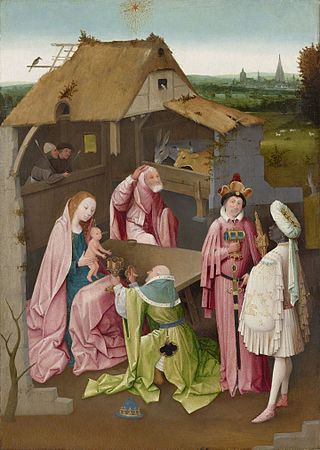
The Adoration of the Magi is an oil painting on wood panel attributed to the workshop of Netherlandish artist Hieronymus Bosch, executed around 1499. It is housed in the Philadelphia Museum of Art, USA. The museum's catalog assign it to around 1518, as having been finished by Bosch's workshop. According to Dendochronologic research, it could have been painted in 1493–1499.

The Adoration of the Magi is an oil painting on wood panel by Netherlandish artist Hieronymus Bosch, executed around 1475. It is housed in the Metropolitan Museum, New York, US. A prominent feature of this painting is the strong perspective effect and also the copious use of gold leaf, which is not very typical for Bosch. The pigments employed are red lake, azurite, lead-tin-yellow and ochres.

Frans Verbeeck or Frans Verbeeck the Elder was a Flemish painter and draughtsman to whom have been attributed a number of works depicting fantastical and grotesque scenes carrying a moralizing intent. He was a member of an important family of artists operating a large workshop with various branches in Mechelen. As it is not always possible to attribute a particular artwork to one or the other family member due to compositional, stylistic, and iconographic similarities, it has been suggested that the works should be attributed to the 'Verbeeck group'. The works were typically executed in tempera or watercolor on linen.

The Flood Panels are two double-sided painted panels attributed to Hieronymus Bosch, dating to c. 1514 and now in the Museum Boijmans Van Beuningen in Rotterdam.

